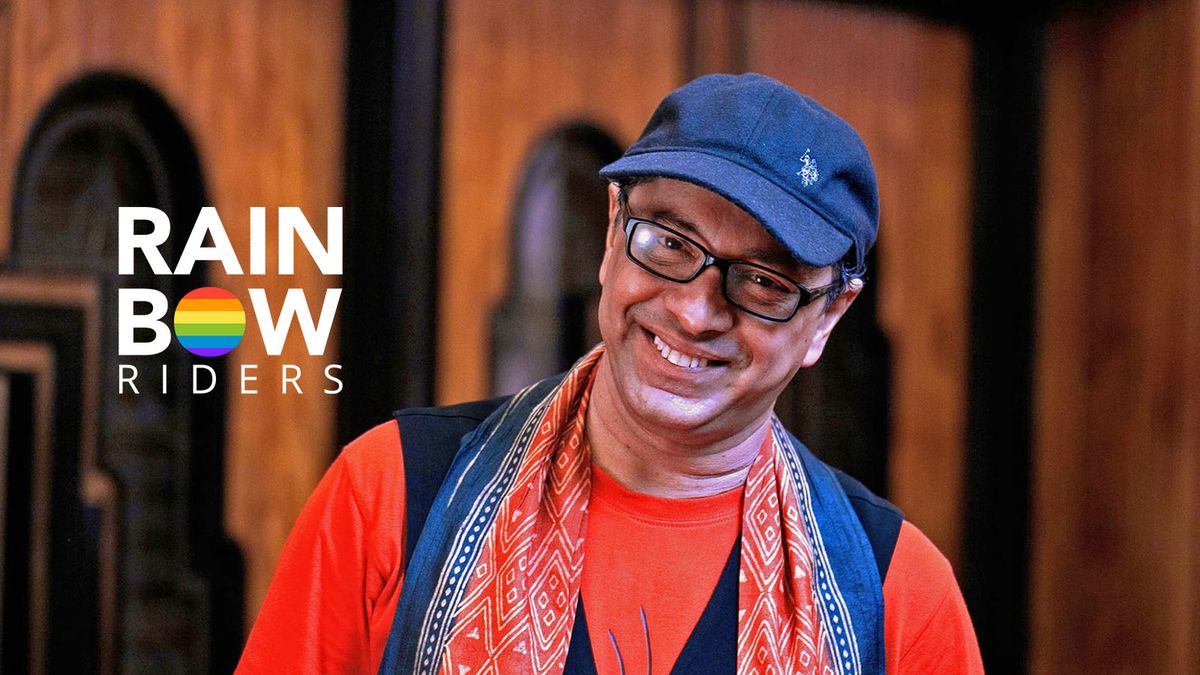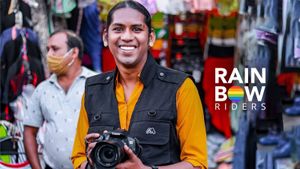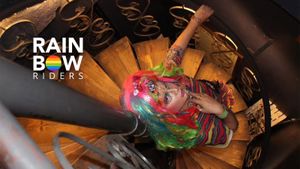When Sridhar Rangayan, Festival Director, KASHISH Mumbai International Queer Film Festival, came out as gay, it was in the pre-social media era. He calls himself a ‘late bloomer’ who took 28 years to come to terms with his sexual orientation. In 1990, he joined hands with Ashok Row Kavi (the first Indian man to publicly come out as gay in 1984) to launch Bombay Dost, India’s first gay magazine. In a candid conversation with Zee Zest, Sridhar shares that it was also a frightening time, “Because we knew gay men were robbed, sexually violated, harassed, and blackmailed not only by hustlers but also by the police. Every sexual encounter was fraught with danger, every night was a nightmare.”
His journey as a filmmaker has been instrumental in breaking taboos about homosexuality through his films with a special focus on queer subjects such as The Pink Mirror and Yours Emotionally. He is the Co-founder Member and Trustee of The Humsafar Trust, the first NGO in India for the LGBTQ+ community, along with Ashok Row Kavi.
Edited excerpts:
1. Tell us about your coming out story.
It is a long story and a complicated one. Coming from a small town traditional family set up, it was even difficult for me to accept my sexuality. I was extremely introverted and shy, perhaps because I knew innately that I was different. I despised myself for feeling this urge to touch, feel, hug, kiss my male friends which I realised wasn’t the norm. Back in the 1960s, ’70s and ’80s, when I was growing up, there was no mention anywhere of homosexuality or someone being gay. Remember all this was before the internet and mobile phones happened to the world! So I was a very late bloomer, I came out even to myself when I was 28. Can you believe it, now kids are coming out when they are 19 or 18 some even at 12-13 years of age?
2. What were the challenges you faced?
Bringing out the Bombay Dost was a Herculean task since no publisher was willing to print a gay magazine (remember this was in 1990). We would be turned out of one printing press after another. We also knew that Section 377 existed and if we were caught with materials on homosexuality in our hands, it could be incriminating evidence and we could be arrested on charges of abetting Section 377. Everything was hush-hush and underground.
But still, we had our share of fun and frolic. While on the one hand, we held/attended underground parties, on the other hand, my home became the adda for many gay men and trans persons to gather together and live a life that they could not do openly outside. We formed our own alternate family where we felt safe and protected. There used to be wild drag dances at our homes, with Bollywood numbers belted out late into the night. We also huddled together for comfort when we went for our first HIV test and were frightened to death.
3. Growing up, were you subject to social stigma and discrimination?
Though I didn’t present myself as very feminine during my school and college days, people still used to tease and humiliate me since I used to grow my hair long and wore printed shirts and fancy bell bottoms (I still wonder how my mom allowed me to wear such clothes!). I was called names and bullied and that dented my self-confidence and made me withdraw into a shell.
It was only between 1990 to 1994 when I came out to myself and all my friends around me, did I have the courage to come out to my family – my mother. In 1994, I had met Saagar Gupta cruising on the streets (this was way before dating apps made everything easy), and found that our compatibility in terms of affinity towards arts and culture, films and poetry could be the foundation of a long-term affair. And since then Saagar and I have been together, now for almost 29 years, a lifetime actually.
4. Did life change after Saagar came into it?
Only after I met Saagar did I come out to my mother and it didn’t go well. She blamed herself and how she brought me up to be the cause that I was gay. My mom has had long conversations and she wanted to know more, learn more about me, and that is truly brave of her. She is a wonderful, caring, loving mom who took many years to accept my sexuality, though she accepted Saagar instantly as my friend, roommate, call what you may! Now I’ve been out to almost all my family members and no one has said anything to my face. Those who didn’t want to associate with me have left quietly, and that is rather graceful I would say. The rest have embraced me and Saagar with love and affection.
5. How did KASHISH happen?
After working in the mainstream television industry for 5 to 6 years (1996-2001), Saagar and I felt that the space didn’t allow stories about our community to be told, since most of the channels said that they are a ‘family’ channel and can’t have any reference to gay, lesbian or transgender stories. In 2001 we quit television and started our own production company, Solaris Pictures, and made our first ever LGBTQ+ themed film Gulabi Aaina (The Pink Mirror) in 2002 which was banned by the censor board in India, but went on to win several awards and travelled to 80+ film festivals. After that we have continued to make LGBTQ+-themed films such as Yours Emotionally!, 68 Pages, Purple Skies, Breaking Free, Evening Shadows, and Raja Bro, etc.
After I travelled to many festivals with my first film and experienced the close community bonds a queer film festival can forge, we decided to start our own queer film festival in Mumbai. KASHISH Mumbai International Queer Film Festival was started in 2010, after the reading down of Section 377 by the Delhi High Court, in one screen at PVR Cinema of 125 seats, and the crowds we witnessed queuing up for the shows were humongous. KASHISH, over the years, has grown to become South Asia’s biggest LGBTQ+ film festival and one of the most important film festivals in India which people look forward to every year.

6. How has KASHISH been instrumental in bringing a change?
The festival brings together the LGBTQ+ community along with their families, friends and colleagues to be together in a safe space to watch LGBTQ+ films on the big screen. KASHISH organises, apart from its annual festival, several screening programs at colleges and cultural institutions across the country in its KASHISH Forward and Best of KASHISH series. Especially in tier 2 and tier 3 cities, these screenings become very important in creating awareness and removing stigma and discrimination. We are also working towards raising discussions around diversity and inclusion among corporate houses through screenings and discussions at their offices or virtually.
The festival has supported several organisations during the pandemic with its We Care Fund which was distributed to Vikalp, Baroda; Café Guftagu, Mumbai; Mitr Trust, New Delhi; Varta Trust, Kolkata and Trans Equality Society, Telangana. But KASHISH’s main contribution is in building and nurturing the nascent Indian queer cinema movement – through a four-pronged approach of development, production, exhibition and distribution of Indian LGBTQ+ films.
7. What’s your take on the Supreme Court reserving its verdict for same-sex marriages?
Saagar and I are petitioners in the marriage equality case at the Supreme Court and we are definitely hoping for a positive verdict. After 29 years of being together, we deserve to get married and have all the rights any couple in this country has, right?
8. According to you, what can change the mindsets of the people and make India a more inclusive country?
We need to get rid of the patriarchal mindset that dominates people in this country. Patriarchy destroys everything that is not cis hetero and male focused. It doesn’t allow for women or sexual minorities to live with the freedom and dignity which is their right. We need to also change school books to teach non-gendered expressions. It cannot always be ‘Raju (male) is going to work’ and ‘Kamla (female) is cooking in the kitchen’ kind of teachings. We need to change these archaic teachings of binary gender expressions. This is the beginning, and when the foundation is right, then the building blocks of future generations will stand solid.
9. With so many campaigns and initiatives taken for the LGBTQIA+ community, do you think there’s been a genuine change?
While the final repeal of Section 377 in 2018 unshackled the Indian LGBTQ+ community from the colonial law, and galvanised more youth to come out, the challenges of social morality and patriarchy (as I have said above) is still stifling equality and dignity for all members of the society. Trans* persons as well as lesbian and bisexual women still face huge challenges to come out and live their life openly and also have equal opportunities for a dignified livelihood. What we need urgently is an anti-discriminatory law that offers protection against any discrimination based on sexual orientation or gender expression.
10. What is your advice to those who are struggling to come out?
Come out only when you are totally comfortable with who you are. Coming out need not always be a loud political statement (for some it works this way), but could be a gentle unravelling of yourself to your friends and family members. Remember, there is no age limit or rush to come out. Be true to yourself; however you want to identify yourself, in whichever way you want to present yourself.





